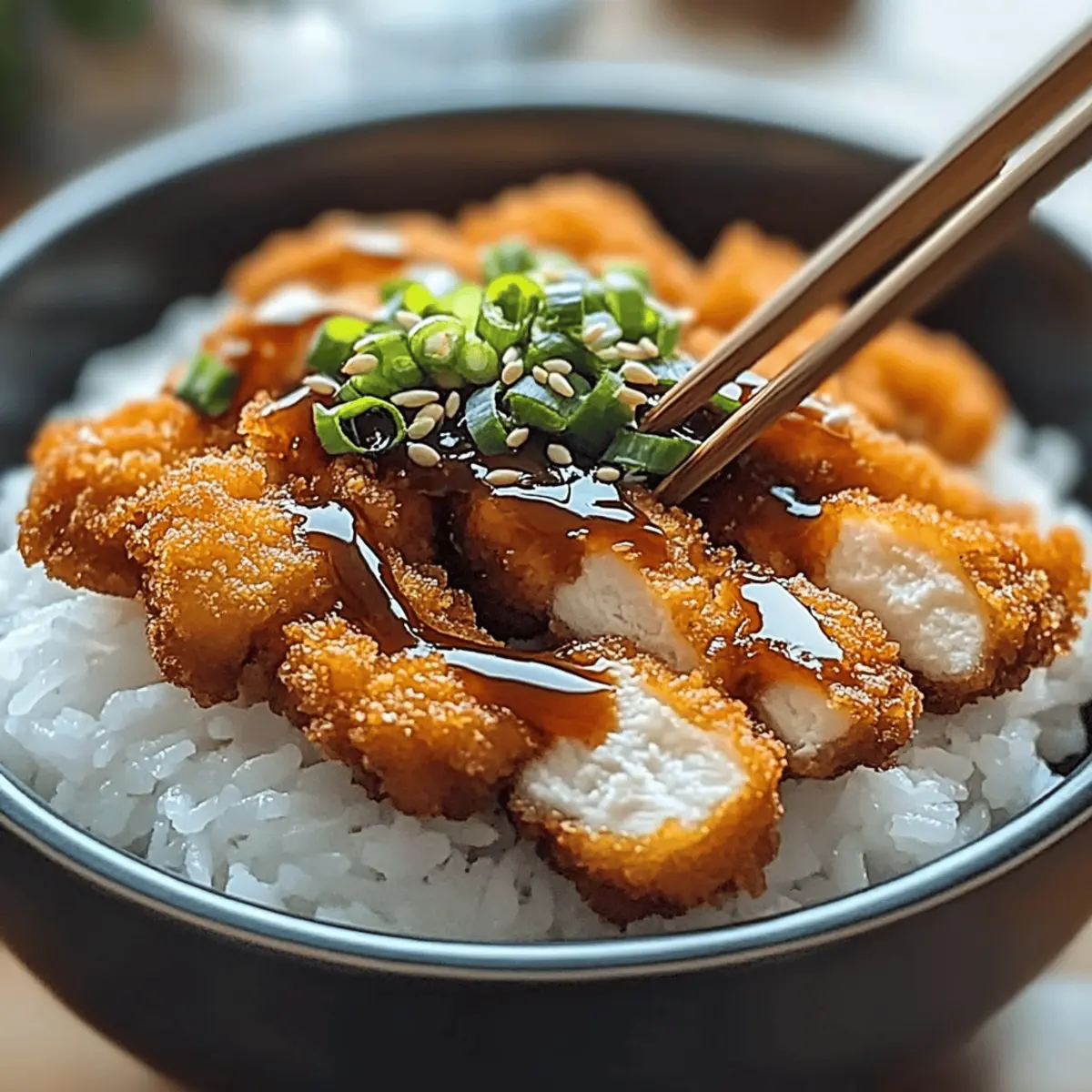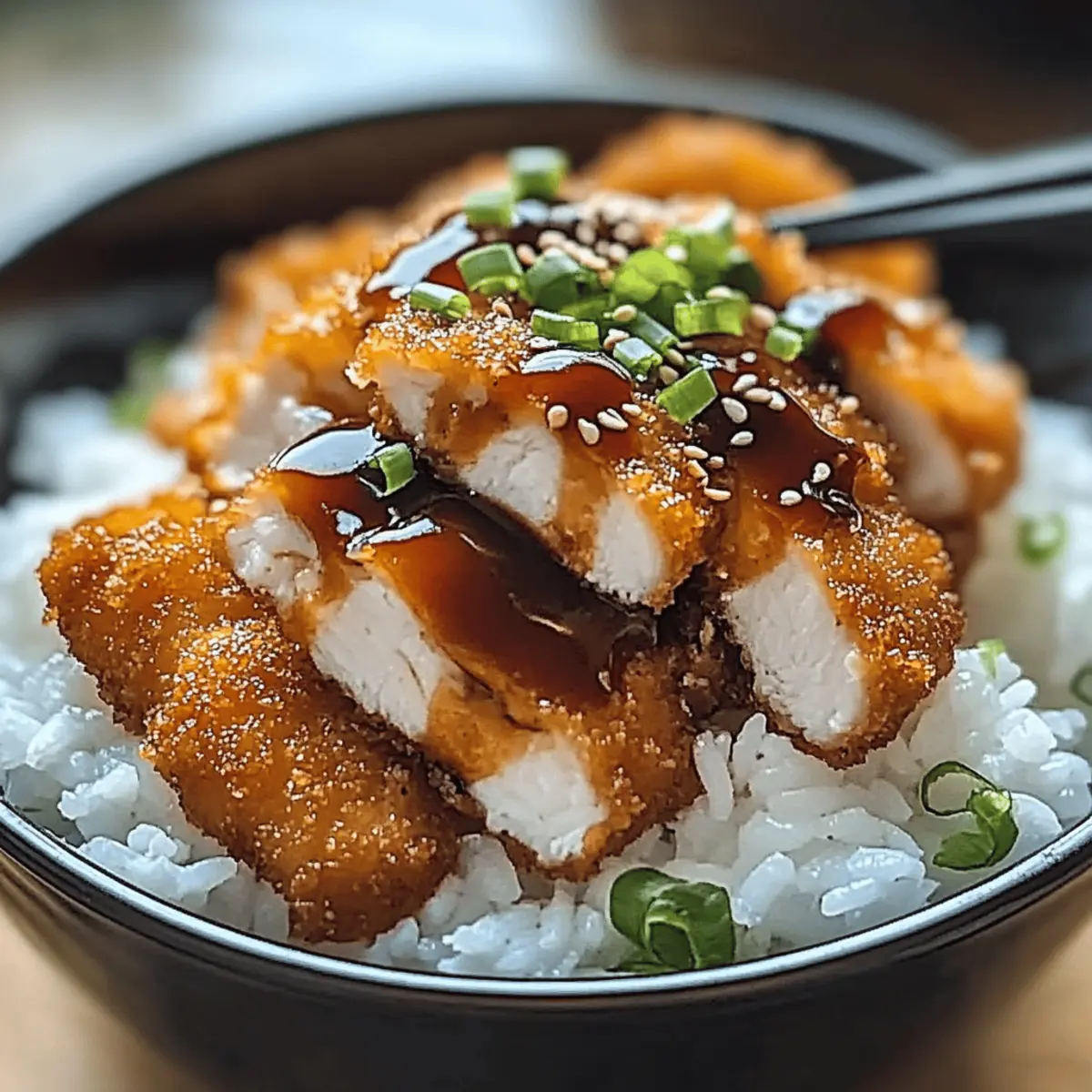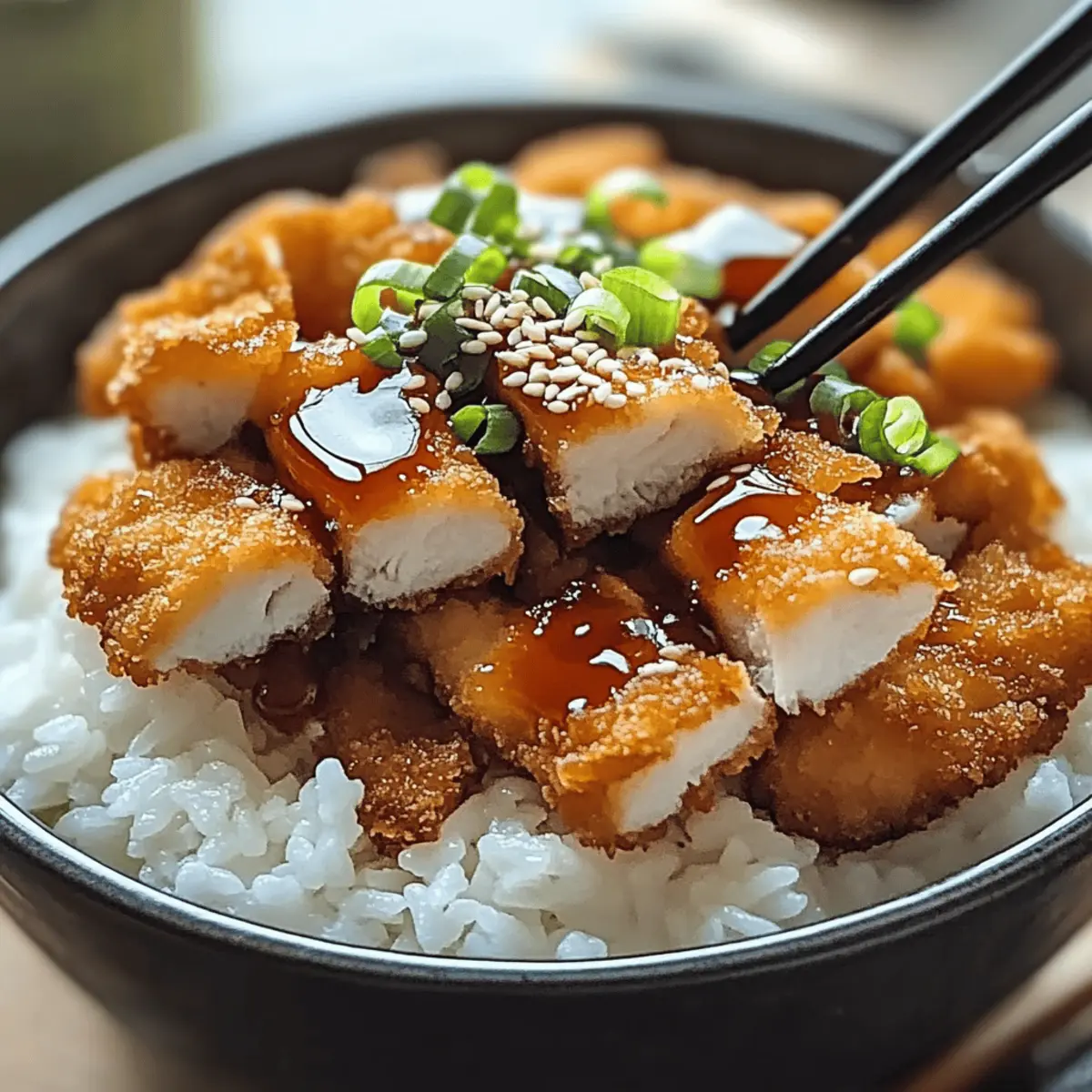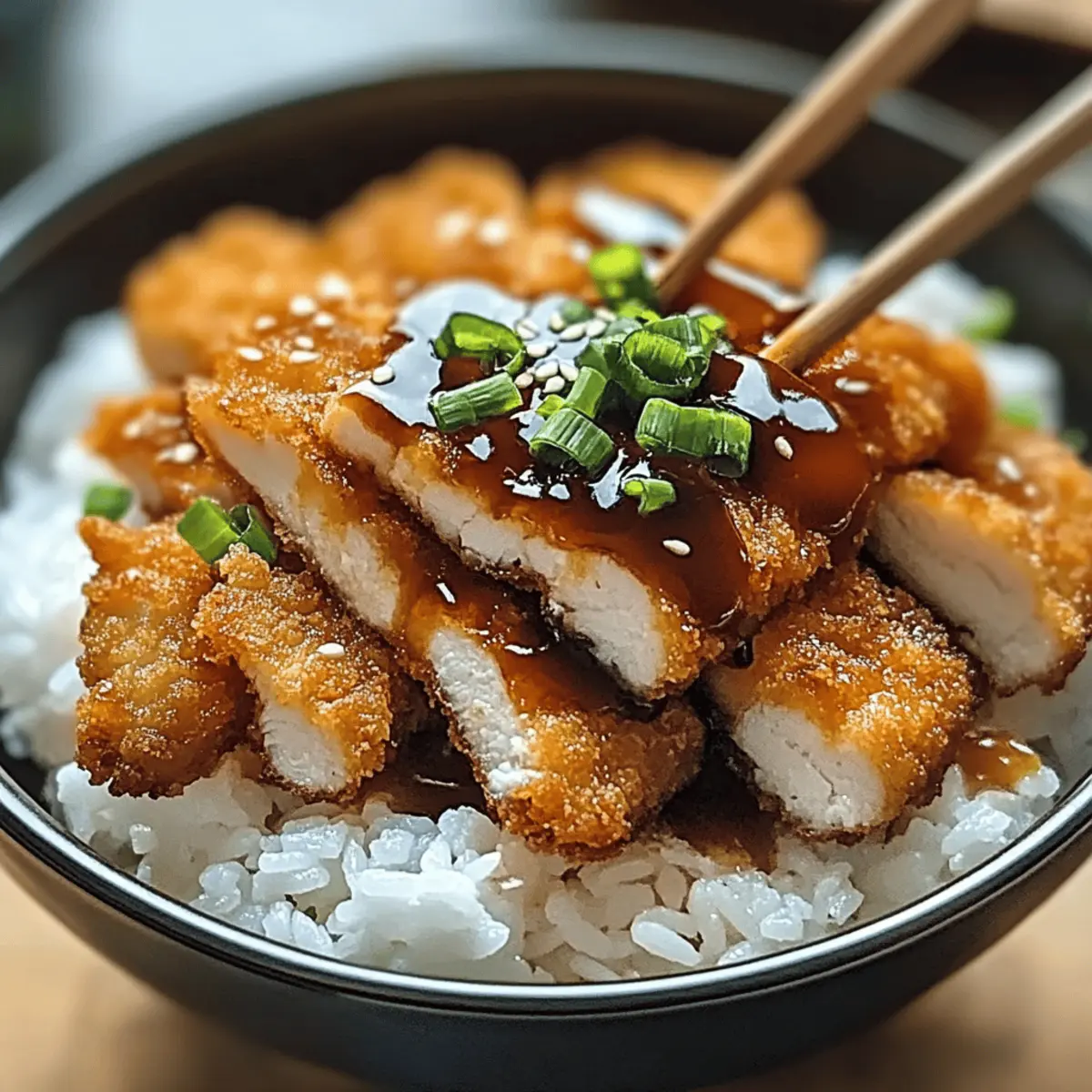There’s something truly magical about diving into a warm bowl of Japanese Katsu Bowls with Tonkatsu Sauce. Picture this: crispy, golden-battered chicken or succulent tofu layered over a bed of fluffy rice, all generously drizzled with a tangy-sweet sauce that dances with flavor. Not only is this dish quick and easy to whip up, but it also invites customization, allowing you to cater to every palate—be it traditional, vegetarian, or with a touch of spice. Whether you’re hosting friends for a cozy dinner or simply treating yourself after a long day, these katsu bowls are your ticket to comfort and satisfaction. Ready to transform your kitchen into a delightful Japanese eatery? Let’s get cooking!

Why Are Katsu Bowls So Irresistible?
Crispy Perfection: The golden-battered chicken provides a satisfying crunch that contrasts beautifully with the tender rice.
Customizable Delight: You can easily swap chicken for tofu or eggplant, making it suitable for everyone, including vegetarians.
Quick and Easy: This recipe comes together in no time, letting you serve up a homemade meal without the fuss of fast food.
Flavor Explosion: The tangy-sweet tonkatsu sauce elevates each bite, turning a simple dish into a flavorful experience.
Crowd-Pleasing Comfort: Perfect for family dinners or dinner parties, these katsu bowls are sure to impress your guests with every bite!
Serve with Style: Pair your bowls with sides like miso soup for a complete and authentic Japanese dining experience.
Japanese Katsu Bowls Ingredients
• Dive into the delightful flavors with these essential ingredients.
For the Protein
- Chicken (or Pork) – Choose chicken breast or pork loin for juicy tenderness, or use firm tofu for a vegetarian option.
- Flour – This coats the protein to help breadcrumbs stick; gluten-free flour works great for those needing a substitution.
- Eggs – They serve as a binding agent for that crispy coating; a flax egg is a perfect vegan alternative.
For the Breading
- Panko Breadcrumbs – These create a delightful crunch when fried; regular breadcrumbs can be swapped but may change the texture.
- Vegetable Oil – Essential for frying; select any neutral oil, like canola, to achieve the ideal crispiness.
For the Base
- Rice – The fluffy foundation for your katsu bowl; short-grain rice is recommended for authenticity, while brown rice is a wholesome choice.
For the Sauce
- Tonkatsu Sauce – This tangy-sweet blend featuring soy sauce, ketchup, Worcestershire sauce, mirin, and sugar brings the dish to life—adjust according to your taste!
Step‑by‑Step Instructions for Japanese Katsu Bowls with Tonkatsu Sauce
Step 1: Prepare Your Protein
Begin by slicing chicken breasts or pork loin into even pieces, about ½ inch thick. This ensures uniform cooking and tenderness throughout. If opting for a vegetarian version, cut firm tofu into similar-sized slabs. This crucial first step sets the foundation for your delicious Japanese Katsu Bowls with Tonkatsu Sauce.
Step 2: Set Up Your Breading Station
Create a breading station by arranging three shallow plates in a line. Fill the first plate with flour, the second with beaten eggs, and the third with panko breadcrumbs. This organized setup will streamline the coating process, helping you achieve that perfect crispy texture for your katsu.
Step 3: Coat the Protein
Take each piece of chicken (or tofu) and dredge it in the flour, ensuring it’s completely coated. Next, dip it into the beaten eggs, allowing any excess to drip off. Finally, roll it in the panko breadcrumbs until thoroughly covered. Press gently to help the breadcrumbs adhere well, which is essential for that delightful crunch in your katsu bowls.
Step 4: Heat the Oil for Frying
In a large skillet, pour in enough vegetable oil to reach a depth of about ¼ inch. Heat the oil over medium heat; it’s ready when a sprinkle of breadcrumbs sizzles upon contact. Maintaining the right temperature is key to achieving a golden-brown crust without burning your delicious Japanese Katsu.
Step 5: Fry the Katsu
Carefully place the breaded chicken (or tofu) into the skillet, avoiding overcrowding. Fry each piece for about 3-4 minutes on one side until it turns golden brown and crispy, then flip and cook for another 3-4 minutes on the other side. Once done, transfer the katsu to a plate lined with paper towels to absorb excess oil.
Step 6: Prepare the Tonkatsu Sauce
In a mixing bowl, whisk together soy sauce, mirin, ketchup, Worcestershire sauce, and sugar until well combined. Taste and adjust the ingredients to find the perfect balance of tang and sweetness that you’ll drizzle over your katsu bowls. This homemade tonkatsu sauce is what elevates the dish to a delightful treat!
Step 7: Assemble the Katsu Bowls
To serve, scoop fluffy cooked rice into serving bowls as the base. Place a generous portion of the crispy chicken (or tofu) on top. Drizzle your flavorful tonkatsu sauce over the katsu, ensuring a delectable coating. For added flair, consider garnishing with pickled ginger, sliced green onions, or sesame seeds!

Make Ahead Options
Japanese Katsu Bowls with Tonkatsu Sauce are perfect for meal prep enthusiasts! You can slice and bread your chicken (or tofu) up to 24 hours in advance—simply coat them and store in a single layer on a baking sheet, covered with plastic wrap to maintain that deliciously crispy texture. The tonkatsu sauce can also be prepared ahead of time and stored in the refrigerator for up to 3 days, which saves you valuable cooking time later. When it’s time to serve, just fry the breaded protein until golden brown and serve over freshly cooked rice, drizzled with your homemade sauce for a delightful meal that’s just as scrumptious as the day it was made!
Japanese Katsu Bowls Variations & Substitutions
Feel free to put your own spin on these delightful katsu bowls and make them truly yours!
- Vegetarian Delight: Substitute chicken with firm tofu or crispy eggplant for a satisfying vegetarian option.
- Gluten-Free: Use gluten-free flour and panko breadcrumbs to make this dish easily digestible for those avoiding gluten.
- Spicy Twist: Add a teaspoon of sriracha or chili garlic sauce to the tonkatsu sauce for a fiery kick that spice lovers will adore.
- Crispy Tempura: Instead of traditional frying, try a light tempura batter for a unique twist on the texture of your katsu.
- Flavorful Marinade: Marinate your protein in soy sauce, garlic, and ginger for an extra punch of flavor before breading.
- Nutrient Boost: Toss some steamed broccoli or carrots in the bowl for added nutrition and vibrant color that makes the meal pop.
- Crispy Fish: Swap out the chicken for flaky white fish like cod or tilapia for a lighter seafood katsu experience.
- Coconut Rice: Consider using coconut milk in your rice for a subtly sweet and tropical flavor, elevating the entire dish.
Looking for more ways to enjoy homemade meals? You might also like these Shells Ground Beef or start your day with this delicious Egg Breakfast Casserole!
What to Serve with Japanese Katsu Bowls with Tonkatsu Sauce
Elevate your katsu experience with delightful pairings that complement the crispy, savory goodness of your homemade feast.
- Miso Soup: The umami-rich flavor of miso soup brings warmth and depth, creating a comforting starter to your meal.
- Steamed Green Vegetables: Lightly seasoned broccoli or snow peas add a fresh, crisp element, balancing the richness of the katsu.
- Pickled Ginger: A tangy bite of pickled ginger refreshes the palate, enhancing each delicious mouthful of katsu and rice.
- Sesame Cucumber Salad: Crunchy cucumbers dressed in sesame oil provide a cooling contrast that beautifully offsets the crispy katsu.
- Japanese Potato Salad: Creamy potato salad slightly sweetened with carrots and cucumbers offers a delightful textural contrast while adding extra comfort to your meal.
- Chilled Sake or Green Tea: Sip on a chilled sake or a refreshing green tea to cleanse your palate, enhancing the overall dining experience.
- Fruit Mochi for Dessert: Finish your meal with colorful fruit mochi—these chewy rice cakes envelop sweet fruit or ice cream, satisfying your sweet tooth in a delightful way!
Storage Tips for Japanese Katsu Bowls with Tonkatsu Sauce
Fridge: Store leftovers in an airtight container for up to three days. This will keep your katsu and rice fresh while preserving flavors.
Freezer: If you want to enjoy your katsu later, freeze the cooked cutlets in a single layer before transferring to a freezer-safe bag. They can last up to three months.
Reheating: When ready to enjoy, reheat in a skillet over medium heat for the best texture. Avoid the microwave to retain that delicious crispiness.
Enjoy Fresh: While you can store components separately, it’s best to assemble your Japanese Katsu Bowls just before serving for maximum flavor and crunch!
Expert Tips for Japanese Katsu Bowls
Crispy Coating: Ensure your oil is hot enough before frying. This will help achieve that signature crispiness for your Japanese Katsu Bowls.
Watch for Burning: Keep an eye on the cooking time; remove the katsu from the oil as soon as it turns golden brown to avoid burning.
Reheat with Care: If you have leftovers, reheat the cutlets in a skillet instead of a microwave to maintain their crunchy texture.
Customization Friendly: Don’t hesitate to experiment with proteins and toppings—such as firm tofu for a vegetarian twist in your katsu bowls!
Sauce Balance: Taste your tonkatsu sauce as you mix it. Adjust sweetness or tanginess according to your preference for the perfect flavor enhancement.

Japanese Katsu Bowls with Tonkatsu Sauce Recipe FAQs
What type of chicken or pork should I use for katsu?
Absolutely! For the best texture and flavor, choose chicken breast or pork loin, as they provide tenderness and juiciness. If you’re considering a vegetarian option, firm tofu works perfectly and absorbs the flavors beautifully.
How should I store leftovers?
Very simple! Store your leftovers in an airtight container in the refrigerator for up to three days. If you have leftover rice, keep it separately to avoid it becoming mushy. Make sure to reheat your katsu in a skillet for that delightful crunch instead of the microwave!
Can I freeze the katsu? How?
Yes, you can! To freeze your cooked katsu, lay the pieces flat in a single layer on a baking sheet and freeze until solid. Once frozen, transfer to a freezer-safe bag, where they can last up to three months! When you’re ready to enjoy them, just reheat in a skillet to retain their crispy texture.
What if my katsu isn’t getting crispy?
If your katsu isn’t turning out crispy, it could be that the oil isn’t hot enough. Preheat it until it sizzles when you drop in a breadcrumb. Additionally, ensure each piece is fully coated in panko; this creates that unbeatable crunch! Remember to avoid overcrowding the pan, which can lower the oil temperature.
Are there any dietary considerations for allergies?
Certainly! If you’re catering to allergies, ensure to use gluten-free flour and breadcrumbs for those with gluten intolerance. The recipe can also be vegan-friendly by substituting chicken with firm tofu and using a flax egg in place of regular eggs. Don’t forget to check your panko brand, as some might contain traces of allergens.
Can I modify the tonkatsu sauce for different flavors?
Yes, feel free to get creative! You can adjust the tanginess or sweetness by varying the amounts of soy sauce or sugar. Additionally, for a spicy kick, add a dash of sriracha or chili oil to the sauce! The more the merrier, so tailor it to suit your palate perfectly.

Savor Homemade Japanese Katsu Bowls with Tonkatsu Sauce
Ingredients
Equipment
Method
- Slice chicken breasts or pork loin into even pieces, about ½ inch thick.
- Set up the breading station with flour, beaten eggs, and panko breadcrumbs in three shallow plates.
- Dredge each piece of protein in flour, dip into beaten eggs, and then roll in panko breadcrumbs.
- Heat vegetable oil in a large skillet to about ¼ inch deep over medium heat.
- Fry the breaded chicken or tofu for 3-4 minutes on each side until golden brown and crispy.
- Whisk together soy sauce, mirin, ketchup, Worcestershire sauce, and sugar for the tonkatsu sauce.
- Serve by scooping rice into bowls, topping with katsu, and drizzling with tonkatsu sauce.

Leave a Reply